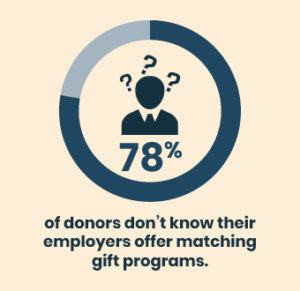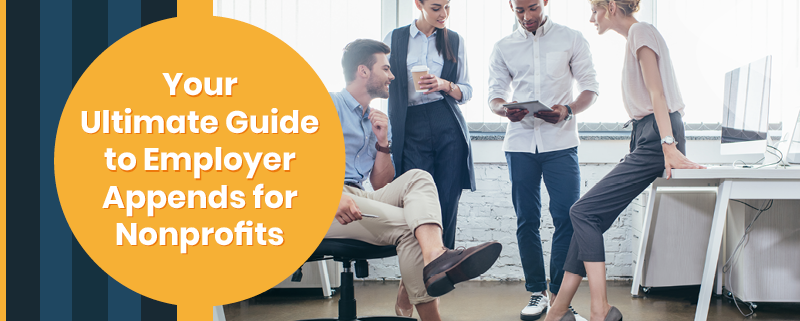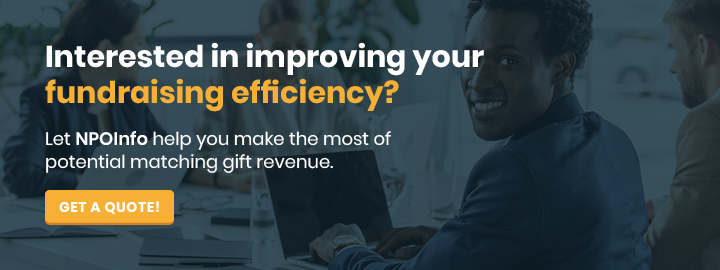Your Ultimate Guide to Employer Appends
Increasing fundraising revenue is a goal for all nonprofits and schools. What if we told you this was possible with data you already have? Appending employer data is one way to maximize your fundraising efforts and prevent potential losses.
Employer appends add data about your donors’ employers to your database. This information provides a variety of valuable insights, including but not limited to whether their employer offers a matching gift program. Information like this can help you capitalize on these fundraising opportunities by educating your donors.
This guide will walk you through the employer appends basics and offer some helpful tips on receiving the best results. We’ll cover the following points:
- What are employer appends for fundraising organization?
- What types of information can you access through an employer append?
- How do employer appends work?
- Tips for appending employer data for fundraising organizations
- Wrapping up: work with NPO Info to append employer data
Let’s get started!
What are employer appends for nonprofits?
Employer appends add information about your donors’ employers to your donor database. Your nonprofit can then use this information to maximize matching gift revenue. This information about employers can help you, and your donors, reap the benefits of their matching gift programs. These matching gifts refer to companies matching your donor’s gift to nonprofits, typically on a 1:1 ratio.
Appending employer data has several benefits. Beyond discovering matching gift opportunities, employment information helps nonprofits learn more about potential corporate social responsibility opportunities. This information can get conversations about corporate sponsorships started and help identify volunteer opportunities. That said, the most important is the potential to increase your fundraising revenue without heavily investing your own resources.
Why append employer data to donor records?
So, why should you append employer data? For starters, you can reduce potential losses in matching gift revenue. Your donors may be unaware that their employers offer these programs and make donations without requesting a matching gift. Here, you lose what is essentially free money from your donors’ employers.
Employer appends close the gap between matching gift revenue and eligible donors. While many donors are eligible for matching gifts, about 78% of them don’t know about their employers’ matching gift programs. If your nonprofit is aware of their eligibility, you can help your donors make a bigger contribution without having to reach back into their own wallets.

What types of nonprofits can benefit from an employer append?
A wide variety of nonprofits reap the benefits of these appends by minimizing matching gift losses. Rather than wondering if you will benefit from an append— you likely will— the question is whether your organization is well positioned for one. The only thing you need to get started is clean donor data.
Clean donor data entails regularly practicing good data hygiene. Data hygiene can involve tasks such as keeping your records current, removing duplicates from your data, and checking for inaccuracies.
While we’ll cover the basics of data hygiene later in this guide, focus on these 3 questions to understand whether your organization is prepared for an employer append:
- Do you have an up-to-date email address? Your data should have a recent email address for donors.
- Do you have an up-to-date mailing address? In addition to an updated email address, it is important to have donors’ most recent mailing address as well.
- For higher education institutions, can you provide graduation years? This piece of data is useful if your nonprofit is a higher education institution like a university. Graduation year can provide insights like how likely someone is to donate based on how long ago they attended.
If you can answer these questions with your current donor data, you’re probably in a good place to start thinking about employer appends.
What types of information can you access through an employer append?
An employer append will grant you access to a few different pieces of information. After appending employer data, you will know your donors’ employer name, their job title, and matching gift information. Here is what this data means for your nonprofit.
Employer Name
Learning who your donors’ employers are is a key part of maximizing fundraising. Once you know the name of a donor’s employer, you can find out about the corporate social responsibility programs their employer may offer that could benefit your nonprofit.
Corporate social responsibility (CSR) refers to efforts a company makes to better society. Because CSR is meant to give back to the community in some way, many companies turn to nonprofits to help them do so. For example, while individual donations make up about 75% of the contributions to a nonprofit, CSR can boost these efforts by companies matching what their employees donate.
Job Title
A donor’s job title can give you insights into how much decision-making power they have at work. It can also tell you something about their financial capacity to give.
Donors working in high positions could be useful leaders within their organizations. These donors could help the organization set up CSR initiatives that benefit your nonprofit. Further, donors who are in advanced positions at their workplace may be more financially capable of donating larger gifts to your organization.
Matching Gift Information
Matching gift information is the key piece of information your nonprofit earns from employer data appends. This information tells you whether your donors’ employer has a matching gift program and if so, how that program works.
If you’re not an expert on matching gift programs, don’t worry. Here is a basic breakdown of the gift match process:
- Donor makes initial gift. The first step in acquiring a matching gift donation is accepting a donation from a donor whose employer offers a matching gift program.
- Donor requests the matching gift. Once your donor makes a donation, they must request a matching gift from their employer. This is where many nonprofits lose potential fundraising. Many donors are unaware that their employers offer these programs and do not request a matching gift.
- Your nonprofit receives a matching gift. If all goes to plan, you will receive a separate donation from your donor’s employer known as a matching gift. These companies usually match gifts at a ratio of 1:1, but some companies match at higher rates of 2:1, 3:1, or 4:1.
The matching gift process is straightforward for your donors, as long as they know about it. That’s the value of an employer append that can provide matching gift information, as you can share educational information with donors who work for match-eligible companies. Your nonprofit can gain at least two donations for the “price” of one— don’t neglect these programs when you could be bringing in free money for your organization!
How do employer appends for nonprofits work?
You might be thinking about what the process for employer appends looks like. There are four steps involved— gathering donor data, maintaining data hygiene, inputting your donor data, and receiving output data. Let’s break down each step.

Step 1: Gather donor data.
One of the only “requirements” for your nonprofit to begin the data append process is to have initial donor records that you’d like to enhance.
Gathering donor data is a crucial step in ensuring you have accurate employer data. Your nonprofit may not have an extensive donor database to work with, but there are many ways to gather more data about donors. Here are a few tips to get you started:
- Use donation forms to gather employee data. Update any existing donation forms to ask donors for employee data. This is a simple and easy way to gather data any time someone makes a donation.
- Evaluate data to identify missing employee data. Perform an audit of your data to pinpoint which donor records are missing employee data. Once you have a smaller list to work with, it is easier to tailor how you gather data.
- Select a data append service. Investing in a data append service like NPOInfo takes the pressure off of you to append data. NPOInfo can help you append employer information, donor addresses, and more.
Securing donor data doesn’t have to be expensive or stressful. Our tips can help get you started with filling in the blanks in donor data.
Step 2: Maintain a high standard of donor data hygiene.
Data hygiene is a process you should practice regularly to keep clean, efficient data. Practicing good data hygiene involves regularly sorting through data to remove things that are irrelevant or inaccurate.
Because employer appends involve adding more data to your database, consider revitalizing your data hygiene practices prior to investing in an append. Analyzing your nonprofit’s data is easier, faster, and more efficient when the data being analyzed is already clean and organized. Clean data will also yield better, more accurate results if you decide to append employer data.
Conduct a sweep of your database and do the following:
- Remove useless records. Remove data that no longer serves your nonprofit. This can include data on deceased donors, minors, or people who are incarcerated.
- Remove any duplicates. Duplicate entries can happen, but they can make data analysis slower. Remove any duplicate entries you find.
- Standardize entries. Make sure that data entries follow a standard formatting pattern. Formatting for things like titles and contact information should be the same across the entire dataset.
From here, you can confidently share data with your data append partner, knowing that you’re providing them with useful information to use in the append process.
Step 3: Input your data.
The next step in the employer append process involves inputting your donor data. Using a source like NPOInfo, supply the service with as much information about your donors as you can. We ask for the following:
- Unique donor ID number
- Name
- Mailing address (for home and/or business)
- Region (state, city, and country)
- Email address
- Phone number
- College or university attended
- Graduation year, major, and degree
- Last gift amount
- Last donation date
- Date the entry was last updated
We know this is a lot of information to ask for all at once. Most organizations don’t have all of this data, so don’t worry if you have some gaps. Strive to fill in as much as possible. Remember, the more data you provide, the more accurate the results will be.
Step 4: Receive your output data.
The final step in this process is receiving the employer data. This data is the result of all the hard work you put into maintaining a high standard of data hygiene! After inputting your data, we supply you with:
- Found flag: This marker indicates if the donor was found. It also tells you if their employer was identified.
- Employer name: This tells you the name of your donors’ employers.
- Matching gift program: This metric indicates whether the employer offers a matching gift program.
- Job title: If possible, NPOInfo supplies the donor’s job title.
- Accuracy rating: This metric is a percentage based on how confident NPOInfo is that the donor and their employer were correctly identified.
Keep in mind that these outputs and their accuracy is based on information your nonprofit provides. These pieces of data are specific to NPOInfo, and other services may differ slightly.
Tips for Appending Employer Data for Nonprofits
While appending employer data is a great way to reduce lost potential in matching gift programs, simply adding new records to your database isn’t enough to truly enhance your nonprofit’s efforts.
Keep these additional tips in mind to make the most of your employer appends.
Make sure donor records are current.
Using up-to-date records is a crucial part of maintaining clean donor data. It is easy to neglect data and forget that it is about real people— people whose addresses can change!
Home addresses are relatively easy to verify. Using the USPS National Change of Address database, you can check your donor data against the addresses listed there. If you notice a donor changed their address, update that information in your database. Don’t let this get out of hand— remember to check in with your data periodically and correct these issues in small batches.
The USPS database is a great way to check donor addresses, but it works best if you are using it for a small amount of data. NPOInfo offers to take care of this for you so you don’t have to spend time manually cross referencing addresses. If you’re finding that you don’t have an extensive database when it comes to addresses, consider investing in NPOInfo’s address appends service.
Up-to-date donor records matter to your nonprofit when it comes to employer appends and contacting your supporters. Old donor addresses don’t ensure as much accuracy as a current one when it comes to employer appends. As for staying in touch with donors, you don’t want to waste ink on a mailer that is sent to their previous address.
Remove any duplicates.
Duplicate entries in data are copies of the same data. For example, you may have the same “Jane Doe” entered into your data twice. While duplications can happen easily during data input, it is important to remove them during data clean ups.
If done regularly, deduplication will save time and effort when it comes time to input data for employer appends. It can also benefit your nonprofit by making running searches and reports on donor data more efficient.
Check in for duplications regularly so they don’t pile up, and remove any that you find.
Look out for inaccuracies.
Inaccurate data can wreak havoc on employer append results. Submitting donor data with inaccurate information will yield less useful information. To make sure employer append services correctly identify your donors, correct information that is:
- Out of date: As we mentioned before, keeping your records up-to-date is a key part of good data hygiene. It is also a factor in your data’s accuracy, as old information is not necessarily correct information.
- Input incorrectly: Look out for things like typos and misspellings. These things can happen due to human error during data input, but correct any that you find while inspecting your data.
- Missing or incomplete: Try to look for incomplete or blank fields of data. You may or may not be able to fill in missing information, but it is helpful to at least flag these issues.
The best way to solve these issues is to stay on top of data hygiene. You should regularly check for old information, typos and misspellings, and incomplete fields. Familiarize yourself with what your data is supposed to look like so any inconsistencies will stick out.
Use employer data to increase fundraising revenue.
After receiving information about your donors’ employers, your next mission is to increase matching gift revenue.
Increasing the number of matching gifts you receive can be as easy as informing donors that the opportunity is available to them. Aim to increase general awareness of these matching gift programs among your donors using existing touch points like newsletters or email lists.
From there, reach out to individual donors who have been identified as match-eligible. Try to educate these donors about what the process of requesting a matching gift looks like from their end to increase the likelihood that they will complete the process. Check out this guide on how to use matching gift forms to understand how it works.
The information you gain from employer appends doesn’t stop at just knowing who your donors’ employers are. Take note of your donors job titles as a way to infer what their donating capabilities may be and consider ways to steward highly successful supporters into making larger gifts in the future.
Wrapping Up: Work with NPOInfo to append employer data.
Now that you’ve learned the ins and outs of employer appends, it’s time to think about next steps. If you decide to use your donor database to append employer data, the service you choose can be a big decision.
NPOInfo makes the process as easy as possible. All you need to do is input as much requested data about your donors as possible, and leave the rest to us! From there, NPOInfo will supply you with information to guide you on your path to maximizing matching gift revenue.
To learn more, contact our team today. In the meantime, while we walked you through the basics of employer appends, there is still a lot you can learn about matching gift programs. Check out some of the resources below to find out more:
- 12 Essential Questions About Corporate Matching Gifts. If you’re new to matching gift programs, you probably have a lot of questions. Check out this resource to learn what matching gift programs are, how nonprofits can market them, and much more.
- How to Use Matching Gift Forms 101: A Nonprofit Guide. Making the most of matching gift programs can get a little technical for you and your donors. This resource walks you through the process of filling out a matching gift form.










